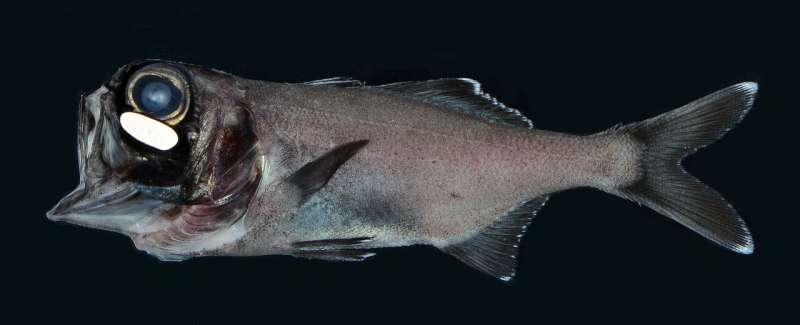Scientists make first observation of fish schooling using bioluminescent flashes

A new study is the first to demonstrate that schooling in fishes can be facilitated by bioluminescent flashes in the absence of ambient light. Led by researchers at the American Museum of Natural History, the research raises the possibility that fish schooling may occur in the deep sea, where it was previously assumed to be too dark for fish to coordinate their movements with each other. The study is published today in the journal PLOS ONE.
"Being in the middle of one of these bioluminescing schools was one of the most magical things I've ever experienced as a marine biologist," said lead author David Gruber, a professor of biology at Baruch College and a research associate at the Museum. Gruber was part of the team that serendipitously came across a school of thousands of flashlight fish (Anomalops katoptron) while scuba diving at night off a remote island in the Solomon Islands. "It was like a moment from the film Avatar as we watched rivers of bioluminescent flashes, like a blue-brick road, descend down the reef."
It is estimated that more than 25 percent of the world's fish species school, a collective behavior that is thought to lower the risk of predation, as well as give the fish greater access to food and mates. But schooling fishes rely on their ability to see one another, an idea that is supported by observations of fish schools dispersing at depths with critically low light levels. So when the team of researchers—including John Sparks, a curator in the Museum's Department of Ichthyology, came across schooling flashlight fish in the pitch dark, it was quite the surprise.
"It was simply astonishing—we observed thousands of flashlight fish using synchronized bioluminescent flashes to coordinate their movement and facilitate schooling behavior in complete darkness, a behavior and function that had not previously been reported for bioluminescence," said Sparks, who is senior author on the paper.
Bioluminescence is visible light generated by living things through a chemical reaction. Flashlight fish, which typically hide in reef crevasses and caves during the day and only venture out on moonless nights, have pockets under their eyes that are filled with bioluminescent bacteria manipulated by an organ that allows them to "flash" with different patterns.
The researchers collected footage of the Solomon Islands school—the largest recorded aggregation of bioluminescent flashlight fish, comprised of thousands of individuals—as part of their 2013 trip, and returned to the remote, uninhabited volcanic island in 2016 and 2019 to gather more data. To capture footage of the fish's nighttime behavior in their natural environment, observations had to be made without artificial light. Both scuba divers and a three-person submarine used a suite of low-light cameras, including a custom-built underwater high-speed, high-resolution scientific complementary metal-oxide-semiconductor (sCMOS) camera.
To capture nighttime imagery of the flashlight fish schooling, Brennan Phillips, an assistant professor of ocean engineering at the University of Rhode Island and a coauthor of the study, modified a deep-sea low-light camera system so that it could be utilized by a scuba diver. "Everything had to come together to get these data—the new camera system, the weather, the divers, and, of course, the fish. It was one of the hardest challenges I have faced as a marine roboticist."
Through a combined analysis of field video recordings and modeling, the researchers demonstrate that the flashlight fish are indeed schooling—synchronizing their behavior and swimming in an oriented, polarized manner relative to one another—and not just "shoaling,"a term that describes a loosely organized group of fish.
"Our finding reveals a completely novel function for bioluminescence in the ocean, and shows that fishes are able to school using only the natural light they emit, without the need to rely on ambient light," Sparks said.
More information: Gruber DF, Phillips BT, O'Brien R, Boominathan V, Veeraraghavan A, Vasan G, et al. (2019) Bioluminescent flashes drive nighttime schooling behavior and synchronized swimming dynamics in flashlight fish. PLoS ONE 14(8): e0219852. doi.org/10.1371/journal.pone.0219852
Journal information: PLoS ONE
Provided by American Museum of Natural History



















